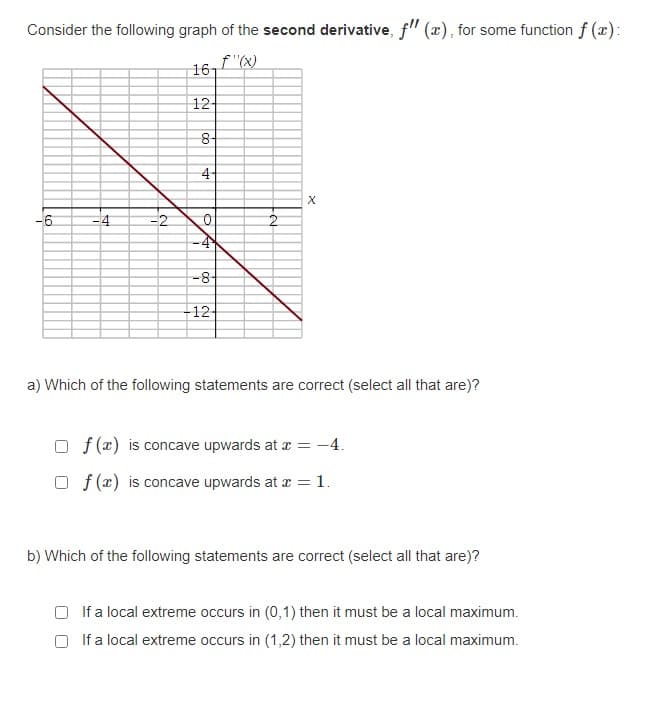Consider the following graph of the second derivative, f" (x), for some function f(x): f"(x) -6 -4 -2 161 12- co 8 4- C 44 -8- -12- IN X a) Which of the following statements are correct (select all that are)? Of(x) is concave upwards at x = -4. Of(x) is concave upwards at x = 1. b) Which of the following statements are correct (select all that are)?
Consider the following graph of the second derivative, f" (x), for some function f(x): f"(x) -6 -4 -2 161 12- co 8 4- C 44 -8- -12- IN X a) Which of the following statements are correct (select all that are)? Of(x) is concave upwards at x = -4. Of(x) is concave upwards at x = 1. b) Which of the following statements are correct (select all that are)?
Chapter3: Functions
Section3.3: Rates Of Change And Behavior Of Graphs
Problem 2SE: If a functionfis increasing on (a,b) and decreasing on (b,c) , then what can be said about the local...
Related questions
Question

Transcribed Image Text:Consider the following graph of the second derivative, f" (x), for some function f (x):
161
12-
-6
-4
-2
co
8
4-
C
-4
-8-
124
IN
X
a) Which of the following statements are correct (select all that are)?
Of(x) is concave upwards at x = -4.
Of(x) is concave upwards at x = 1.
b) Which of the following statements are correct (select all that are)?
If a local extreme occurs in (0,1) then it must be a local maximum.
If a local extreme occurs in (1,2) then it must be a local maximum.
Expert Solution
This question has been solved!
Explore an expertly crafted, step-by-step solution for a thorough understanding of key concepts.
Step by step
Solved in 2 steps with 2 images

Recommended textbooks for you


College Algebra
Algebra
ISBN:
9781305115545
Author:
James Stewart, Lothar Redlin, Saleem Watson
Publisher:
Cengage Learning


College Algebra
Algebra
ISBN:
9781305115545
Author:
James Stewart, Lothar Redlin, Saleem Watson
Publisher:
Cengage Learning